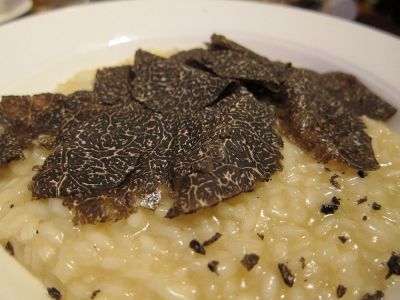Il tartufo è un frutto della terra conosciuto sin dai tempi più antichi. Nasce e vive sotto terra, dove cresce spontaneamente nel terreno sulle radici di alcuni alberi. È composto da una parte esterna a volte liscia ed a volte rugosa e da una massa interna carnosa il cui colore varia dal rosa al grigio, al bianco, al marrone. Il tipico profumo penetrante e persistente si sviluppa solo a maturazione avvenuta e ha lo scopo naturale di attirare gli animali selvatici per spargere le spore contenute e perpetuare la specie. È un gastronomico estremamente pregiato e ricercato, sia per le sue proprietà nutrizionali che per la caratteristica fragranza del suo gusto che lo rende da secoli famoso sulle tavole più ricercate e raffinate di tutto il mondo. Mentre il tartufo nero può essere consumato in gran quantità ed è commestibile solo se cotto, quello bianco, invece, serve ad aromatizzare, va utilizzato con parsimonia e può essere servito crudo, grattugiandolo direttamente sui cibi. Infine, se i tartufi neri sono più facili da trovare, quelli bianchi sono prerogativa esclusiva di alcune regioni italiane come Piemonte, Emilia Romagna, Marche, Umbria, Abruzzo, Molise, Basilicata e Calabria.
Nothing better completes the year more than autumn celebrations which captivate people and show them fun and fresh things to discover. Italy is a country full of celebration and tradition and the food of this country is no exception. It is interesting to note that the autumn season isn’t just for All Saint’s Day and other holidays, but it also contains white truffle season.
White truffle (tartufo bianco) season takes place in the autumn of Italy, specifically from late October to early November. Truffles are an important culinary piece in Italian dishes and this ingredient gathered so much notoriety over the years that entire festivals are held in celebration of it. The white truffle is used in both expensive and local dishes and its heavenly taste and aroma captivates endless amounts of palates across not only Italy but the entire world, as well.
A truffle is considered a fungus and it is related to the mushroom. It is located by trained harvesters who often use dogs or pigs to sniff out the tricky ingredient and it must be carefully dug up. Without the help of these four-legged companions, the truffle would be close to impossible to locate. The truffles are then cleaned and sold and some white truffles cost hundreds if not thousands of dollars.
White truffles are typically served fresh for eating. They can be served with a variety of meals and they can make wonderful ingredients for various dishes as well. They are far too delicate to be used for cooking, unlike the black truffle (tartufo nero) which can be cooked and tastily served. A variety of truffles can be harvested year-round, but the white truffle truly shines best in the autumn season.
One of the major celebrations of the white truffle is held in Alba, which is located in the Piedmont region in northern Italy. It is considered the main place to go to enjoy truffle-related celebrations and goodies since the 1920s. Travelers can visit this area during the autumn season to partake in not only truffle-related food tasting, but many other celebratory events as well: wine tastings, getting to know the local farmers, entertainment, auctions, and more.
With such an enormous following and unique taste, there is no wonder that the white truffle is considered such a wonderful Italian delicacy. Trying a white truffle-inspired dish may be on every Italian’s bucket list for various reasons, whether it’s to get in touch with heritage, to try a new cooking skill or simply to savor a taste that has captivated the globe for innumerable years. Happy eating!



